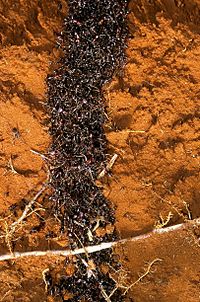
Cuticular hydrocarbons as potential mediators of cryptic species divergence in a mutualistic ant association
Sign Up to like & getrecommendations! Published in 2019 at "Ecology and Evolution"
DOI: 10.1002/ece3.5464
Abstract: Abstract Upon advances in sequencing techniques, more and more morphologically identical organisms are identified as cryptic species. Often, mutualistic interactions are proposed as drivers of diversification. Species of the neotropical parabiotic ant association between Crematogaster… read more here.
Keywords: cryptic species; ant association; chc profiles; association ... See more keywords

Genetic divergence and phenotypic plasticity contribute to variation in cuticular hydrocarbons in the seaweed fly Coelopa frigida
Sign Up to like & getrecommendations! Published in 2019 at "Ecology and Evolution"
DOI: 10.1002/ece3.5690
Abstract: Abstract Cuticular hydrocarbons (CHCs) form the boundary between insects and their environments and often act as essential cues for species, mate, and kin recognition. This complex polygenic trait can be highly variable both among and… read more here.
Keywords: variation; fly coelopa; seaweed fly; coelopa frigida ... See more keywords

Intraspecific variation of cuticular hydrocarbons in the eusocial wasp Polybia sericea (Hymenoptera: Vespidae)
Sign Up to like & getrecommendations! Published in 2021 at "Chemoecology"
DOI: 10.1007/s00049-021-00355-3
Abstract: Chemical communication is fundamental to maintain cohesion in social insect colonies, and in this communication process, cuticular hydrocarbons act as cues exchanged during interactions between nestmates. However, few studies have investigated intraspecific variation of these… read more here.
Keywords: cuticular hydrocarbons; polybia sericea; intraspecific variation; cuticular chemical ... See more keywords

Cuticular hydrocarbons for the identification and geographic assignment of empty puparia of forensically important flies
Sign Up to like & getrecommendations! Published in 2022 at "International Journal of Legal Medicine"
DOI: 10.1007/s00414-022-02786-1
Abstract: Research in social insects has shown that hydrocarbons on their cuticle are species-specific. This has also been proven for Diptera and is a promising tool for identifying important fly taxa in Forensic Entomology. Sometimes the… read more here.
Keywords: forensically important; empty puparia; hydrocarbons identification; cuticular hydrocarbons ... See more keywords

Cuticular hydrocarbon pattern as a chemotaxonomy marker to assess six species of thrips
Sign Up to like & getrecommendations! Published in 2020 at "Journal of Asia-pacific Entomology"
DOI: 10.1016/j.aspen.2020.10.005
Abstract: Abstract Thrips constitute several families of slender insects with fringed wings and unique asymmetrical mouthparts. They have become globally important pests, infesting a variety of agriculturally important crops. Species of thrips are difficult to identify… read more here.
Keywords: chemotaxonomy; hydrocarbon pattern; hydrocarbon; cuticular hydrocarbon ... See more keywords

The potential use of cuticular hydrocarbons and multivariate analysis to age empty puparial cases of Calliphora vicina and Lucilia sericata
Sign Up to like & getrecommendations! Published in 2017 at "Scientific Reports"
DOI: 10.1038/s41598-017-01667-7
Abstract: Cuticular hydrocarbons (CHC) have been successfully used in the field of forensic entomology for identifying and ageing forensically important blowfly species, primarily in the larval stages. However in older scenes where all other entomological evidence is… read more here.
Keywords: vicina lucilia; age; analysis; puparial cases ... See more keywords

The role of cuticular hydrocarbons in mate recognition in Drosophila suzukii
Sign Up to like & getrecommendations! Published in 2018 at "Scientific Reports"
DOI: 10.1038/s41598-018-23189-6
Abstract: Cuticular hydrocarbons (CHCs) play a central role in the chemical communication of many insects. In Drosophila suzukii, an economically important pest insect, very little is known about chemical communication and the possible role of CHCs.… read more here.
Keywords: cuticular hydrocarbons; mate recognition; role; drosophila suzukii ... See more keywords

Cuticular hydrocarbons for identifying Sarcophagidae (Diptera)
Sign Up to like & getrecommendations! Published in 2021 at "Scientific Reports"
DOI: 10.1038/s41598-021-87221-y
Abstract: The composition and quantity of insect cuticular hydrocarbons (CHCs) can be species-specific as well as sexually dimorphic within species. CHC analysis has been previously used for identification and ageing purposes for several insect orders including… read more here.
Keywords: identifying sarcophagidae; hydrocarbons identifying; males females; sarcophagidae diptera ... See more keywords

Temporal Changes in Cuticular Hydrocarbons During Worker-Reproductive Transition in the Eastern Subterranean Termite (Blattodea: Rhinotermitidae)
Sign Up to like & getrecommendations! Published in 2020 at "Annals of the Entomological Society of America"
DOI: 10.1093/aesa/saaa027
Abstract: Abstract In social insects, the reproductive division of labor is often regulated through communication using cuticular hydrocarbons (CHCs) that indicate caste identity and reproductive status. In many termites, workers retain reproductive potential and can differentiate… read more here.
Keywords: subterranean termite; transition; age; blattodea rhinotermitidae ... See more keywords

Body Size and Cuticular Hydrocarbons as Larval Age Indicators in the Forensic Blow Fly, Chrysomya albiceps (Diptera: Calliphoridae)
Sign Up to like & getrecommendations! Published in 2020 at "Journal of Medical Entomology"
DOI: 10.1093/jme/tjaa256
Abstract: Abstract Chrysomya albiceps (Wiedemann 1819) is one of the most important insects in forensic entomology. Its larval developmental and survival rates are influenced by nutritional resources, temperature, humidity, and geographical regions. The present study investigated… read more here.
Keywords: larval; entomology; cuticular hydrocarbons; body size ... See more keywords